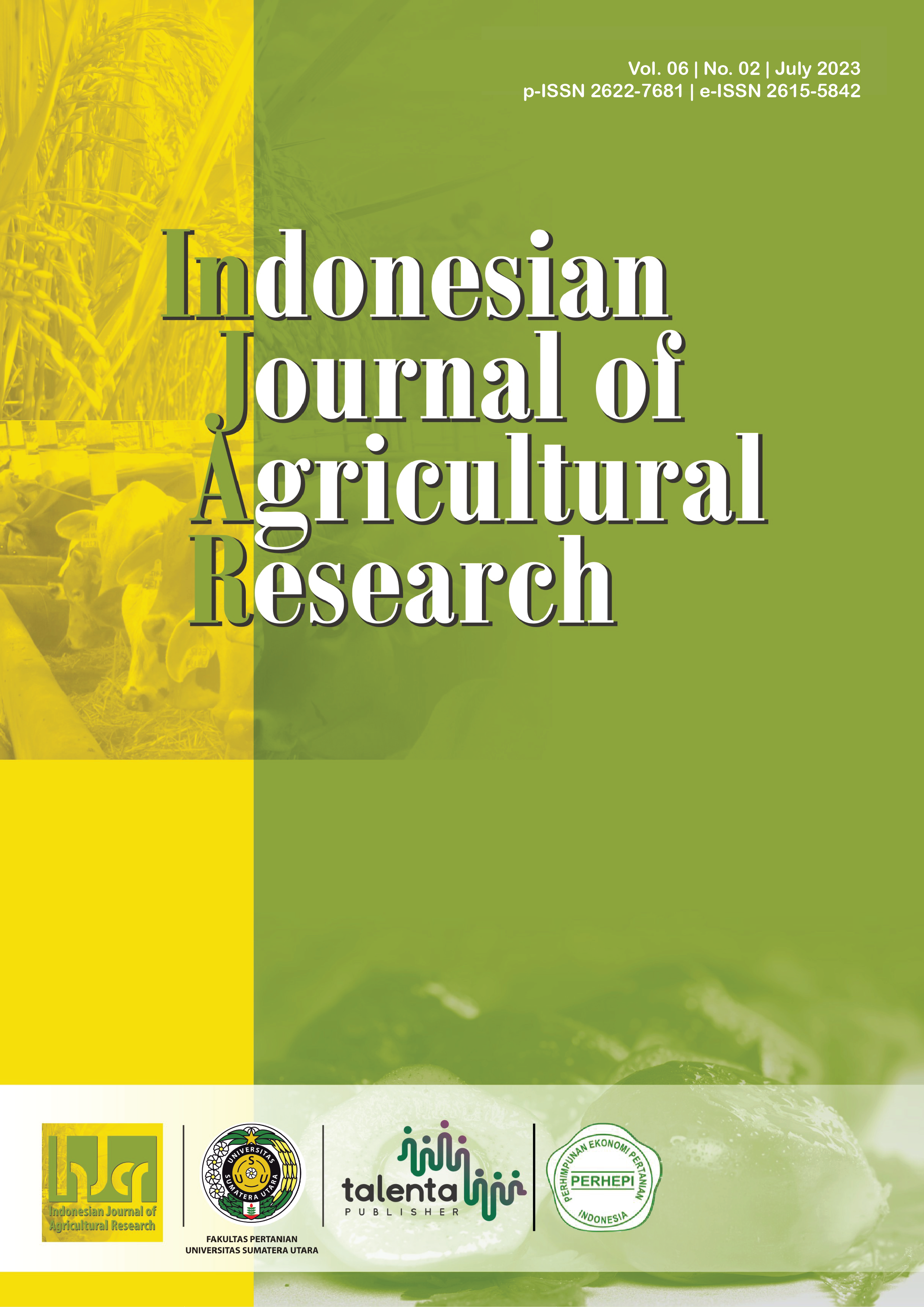Effect of Red Ginger Addition and Drying Temperature Variations on Quality Characteristics and Antioxidant of Cat’s Whiskers Leaf Teabags
DOI:
https://doi.org/10.32734/injar.v6i2.12191Keywords:
antioxidant, cat’s whiskers leaf, herbal tea, red ginger, temperatureAbstract
Tea is a type of beverage that is widely consumed in various countries due to its high antioxidant content and its beneficial for health. This study was conducted to determine the effect of the addition of red ginger and variations in drying temperature on the quality characteristics and antioxidant content of cat whisker leaf tea bags. The study used a factorial Completely Randomized Design (CRD) method consisting of two factors, the addition of red ginger (10%, 20%, 30%, and 40%) and variations in drying temperature (40oC, 50oC, and 60oC). The results show that the addition of red ginger had a highly significant effect on water content, ash content, water-soluble ash content, crude fiber content, pH, antioxidant content, aroma hedonic value, taste hedonic value, and general acceptance hedonic value. Variations in drying temperature had a highly significant effect on water content, ash content, water-soluble ash content, fiber content, and antioxidant content. This variation of drying temperature also had no significant effect on pH, hedonic aroma value, taste hedonic value, color hedonic value, and general acceptance hedonic value. The best results showed that the addition of ginger at 40% and a drying temperature of 60oC resulted in the best quality of tea bags.
Downloads
References
R. Yulianti, D. A. Nugraha, and L. Nurdianti, “Formulation of liquid soap preparation from leaf extract of kidney tea (Orthosiphon aristatus (BI) Miq.),†Kartika-J. Pharmaceutical Science, vol. 3, no. 2, pp. 1-11, Dec, 2015.
P. Pratiwi, M. Suzery, and B. Cahyono, “Total phenolics and flavonoids from the extract and fraction of the leaves of the cat whiskers (Orthosiphon stamineus B) of central Java and their antioxidant activity,†J. Science and Mathematics, vol. 18, no. 4, pp. 140-148, Feb, 2014.
Kawiji, R. Utami, and E. N. Himawan, “Utilization of ginger (Zingiber officinale rosc.) in increasing shelf life and antioxidant activity of wet sale,†J. Agricultural Product Technology, vol. 4, no. 2, pp. 113-119, Aug, 2011.
Dry Tea Quality Requirements, SNI 03-3836, 2012.
I. N. C. Lagawa, P. K. D. Kencana, and I. G. N. A. Aviantara, “Effect of withering time and drying temperature on the characteristics of stoic bamboo leaf herbal tea (Gigantochloa nigrociliata BUSE-KURZ),†J. Biosystems and Agricultural Engineering, vol. 8, no. 2,
pp. 223-230, Sep, 2020.
N. A. Verenzia, Sukardi, Mujianto, and M. Wachid, “Physicochemical and organoleptic characterization of sticks with formulations of lemon flour (Citrus limon L) and red ginger starch (Zingiber officinale var Rubrum),†Food Technology and Halal Science Journal, vol. 5, no. 1, pp. 93-108, Jan, 2022.
Quality Requirements for Dried Ginger, SNI 01-3393, 1994.
A. M. Salasa, and T. Abdullah, “Total flavonoid content and antioxidant activity of cat whiskers leaf extract (Orthosiphon stamnieus B.),†J. Pharmaceutical Media, vol. 17, no. 2, pp. 162-167, Okt, 2021.
I. E. Herawati, and N. M. Saptarini, “Study of phytochemicals in red ginger (Zingiber officinale Roscoe Var. Sunti Val),†J. Pharmaceutics Magazine, vol. 4, no. 1, pp. 22-27, Dec, 2021.
H. Rahmi, “Antioxidant activity of various sources of fruits in Indonesia,†Indonesian Agrotech Journal, vol. 2, no. 1, pp. 34-38, Jan, 2017.
D. A. T. Ulandari, K. A. Nocianitri, and N. M. I. H. Arihantana, “Effect of drying temperature on the content of bioactive components and sensory characteristics of white poeny tea,†J. Food Science and Technology, vol. 8, no. 1, pp. 36-47, Mar, 2019.
M. I. P. Atmaja, H. Maulana, Shabri, G. P. Riski, A. Fauziah, and S. Harianto, “Evaluation of the conformity of tea product quality with the requirements of Indonesian national standards,†J. Standardization, vol. 23, no. 1, pp. 43-52, Mar, 2021.
Black Tea Quality Requirements, SNI 01-3753, 1995.
A. Matin, F. Mahmud, S. Akhter, N. Rahman, and F. B. H. Ahmad, “Appraise the phsyio-chemical quality of black tea available in the local market of chattogram,†Bangladesh Journal of Veterinary and Animal Sciences, vol. 8, no. 1, pp. 128-132, Jan, 2020.
D. Muzaki, and R. Wahyu, “Effect of the addition of dry gingger (Zingiber officinale) on the quality and acceptability of south african leaf herbal tea (Vernonia amygdalina),â€
J. Food Technology, vol. 6, no. 2, pp. 67- 75, Nov, 2015.
W. K. Dewi, N. Harun, and Y. Zalfiatri, “Utilization of katuk leaf (Sauropus adrogynus) in the manufacture of herbal tea with dried temperature variations,†JOM FAPERTA,
vol. 4, no. 2, pp. 1-10, Okt, 2017.
J. K. S. Lung, and D. P. Destiani, “Test the antioxidant activity of vitamins A, C, E with the DPPH method,†J. Farmaka, vol. 15, no. 1, pp. 53-62.
K. A. M. Savitri, I. W. R. Widarta, and A. A. G. N. A. Jambe, “The effect of comparison of black tea (Camellia sinensis) and red ginger (Zingiber officinale var. Rubrum) on the characteristics of teabags,†J. Food Science and Technology, vol. 8, no. 4, pp. 419-429, Dec, 2019.
C. Saparinto and R. Susiana, Grow Your Own Medical Plant. Yogyakarta, Indonesia: Lily Publisher, 2016.
J. Wang, P. Li, S. Liu, B. Zhang, Y. Hu, H. Ma, and S. Wang, “Green tea leaf powder prevents dyslipidemia in high-fat diet-fed mice by modulating gut microbiota,†Food and Nutrition Research, vol. 64, no. 1, pp. 1-14, Nov, 2020.
G. Soma, S. Mahadevamma, and M. L. Sudha, “Characterisation of tea fiber and its utilisation as a functional ingredients in preparation of biscuits,†International Food Research Journal, vol. 23, no. 6, pp. 2525-2533, Dec, 2016.
N. L. A. Yusasrini and L. P. T. Darmayanti, “Lipid profile improving effect of tenggulun leaf (Protium javanicum) tea powder in rats fed with high-fat diet,†J. Food Nutrition,
vol. 17, no. 2, pp. 87-94, Jul, 2022.
Downloads
Published
How to Cite
Issue
Section
License
Copyright (c) 2023 Indonesian Journal of Agricultural Research

This work is licensed under a Creative Commons Attribution-NonCommercial-ShareAlike 4.0 International License.



















